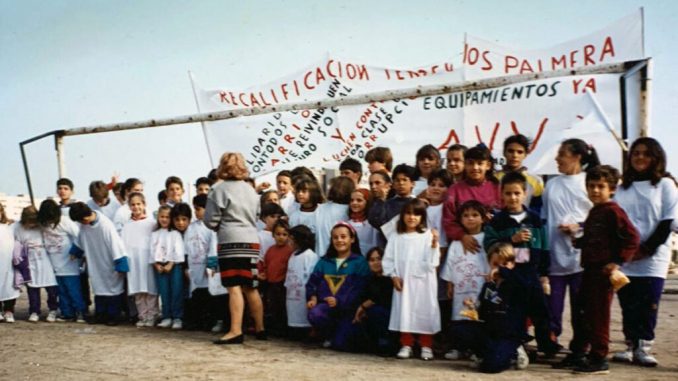
Protest of the neighbors of the Besòs demanding more equipment. Photograph: Arxiu AV Besòs / Desdelamina.net
First Conferences on Margins and Urban Peripheries
The most important urban revolt that Barcelona has known since the civil war, was on October 1990 in the Besòs neighborhood. This conflict had to do with a situation in which there was a solar, the solar of the palm tree, which resided under the paradigm of a type of broader movement that responds to the idea of “Not in My Backyard” (NIMBY).
Arosed a Govern’s initiative to build buildings in that space. A space that had long been claimed by the neighbors of the Besòs, a neighborhood of blocks of the late 60s. In this conflict took place the first act of public order at this level of the body of the Mossos d’Esquadra. Police violence was intense, brutal in many ways.
Both the Besòs and the Mina were considered peripheral and suburbal neighborhoods that shared their low urban quality, as well as the oblivion to which they had been subjected by the public administrations. Both occupied, and still occupy, a coveted area for the development of a new region. This happens precisely at the time of completion of the major works that should incorporate this infrastructural change in what would be the Olympic Barcelona. Process of the gradual connection of the neighborhoods of the mouth of the river Besòs to the Metropolitan Barcelona in order to allow its expansion (Plan de la Ribera).
The project to eradicate La Mina and the transfer of its neighbors to the Besòs involved merging and confusing a slum with a neighborhood of “honoured working people”, integrated even in a precarious way in the order of the city. In this material hierarchy, but also symbolic, the slum was in the lowest instance, always about to rush into the abyss lurking of social disorganisation. In reference to Louis Chevalier’s classic proposal (1958) between “dangerous classes” and “working classes”, different not only because they constitute distinct sources of danger to the dominant order, but also because of the distance between them as a way of life. The dangerous classes are singled out by rejecting both the middle class models, and the factory discipline that end it up, taking on the working class as its own, even for its disobedience. Therefore, the notion of social exclusion is a kind of artifact that serves precisely to warn the individuals of the risks that they may incur in case they not allow to be exploited.
Chevalier, L. (1969 [1958]). Classes laborieuses et classes dangereuses à Paris pendant la première moitié du XIXe siècle. París: Plon.
Delgado, M. (2016). “Luchas centrales en barrios periféricos: La ‘intifada del Besòs’, Sant Adrià del Besòs, octubre 1990”. In G. Aricó, J. Mansilla y L. Stanchieri (coord.) Barrios corsarios: memoria histórica, luchas urbanas y cambio social en los márgenes de la ciudad neoliberal. Barcelona: Pol·len, pages. 57-76
To learn more about the conflict: https://observatoriconflicteurba.org/2015/10/27/a-25-anos-de-la-intifada-del-besos-o-la-apropiacion-simbolica-del-conflicto-urbano-en-el-margen-derecho-del-besos/
Besos al Besòs. Revolta urbana Sant Adrià del Besòs. Barcelona, 1990.
“La intifada del Besòs, 1990. De la explotación a la exclusión” – Manuel Delgado